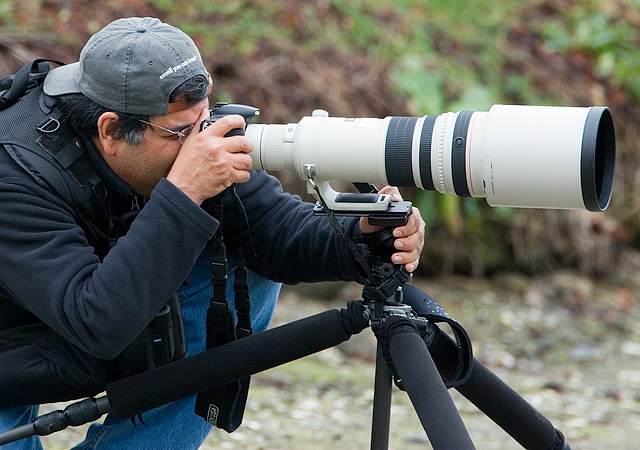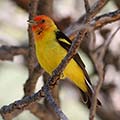What camera do you use?
I get asked that question a lot. I usually say Canon. And leave it that.
The truth is it doesn't matter. Would you ask an artist what brand of canvas they use? It's a common myth that a great camera will help you take better pictures. It won't. For example, the most favored photographer on flickr, imapix (his screen handle), often uses a cheap 2 megapixel consumer-quality pocket camera.
The great photographer Ansel Adams once pointed out that great photographers don't take pictures - they make them. When you watch a great bird photographer like Arthur Morris make pictures, you can see that he plans the scene well ahead of time. He know what composition he would like, where he wants the shadows, what he wants for the background, and how he's going to manipulate the shutter speed and f-stop to get the picture he wants to make.
When you make pictures, the most important thing is light. Then lens. Then shutter-speed (for birds, the fstop is set ahead of time). Sometimes I get asked what lens do you use...That's a great question. That's asked by someone who really wants to be a bird photographer. Sometimes I get asked to give Photoshop tips and tricks. That's a bird photographer who's going to be a happy photographer with some great shots.
My recommendation for most valuable photographic tool, besides Photoshop? Knee-pads. If you can, get eye-level with the bird. Start kneeling in the mud (and bird poop!) and you'll see what a difference it makes.
The natural progression for bird photographers seems to be:
- Buy a compact digital sub 5Mpixel - spend $300 to $500
- Decide that's totally useless (1 out of 500 shots ok....)
- Buy a scope and plan on digiscoping
- Like the scope but decide digiscoping is totally useless
- Get a better digiscoping camera (1 out 300 shots successful)
- Decide that's totally useless (although sparkyfaisca on flickr does very well)
- Get a big zoom lens (people spring for Canon 20D and 100-400 typically)
- Decide that your pictures still lack quality compared to other folks
- Buy a 400mm/5.6
- Start taking decent pictures (1 out of 100 successful)
- Learn Photoshop
- Buy a 500 mm (big bucks) - take lots of full frame birds
- Learn Photoshop
- Buy a lot of gear to make your 500 take non-blurry shots (ie. tripods, heads, etc.)
- Learn Photoshop
- Decide lugging around 40 to 50 pounds of equipment is hard.
- Learn Photoshop
- Buy a 70-200mm L lens - take lots of flock shots
- Learn Photoshop
- Buy compact digital sub 5Mpixel - spend 300 to 500 (just kidding)..
Point being...
Learn Photoshop - Photoshop makes a good lens perform great
Learn Photoshop - Poor photoshop skills make a great lens seem weak
I chose Canon because they have a better autofocus telephoto. The lens matters obviously. The camera bodies come and go. When I hit the lottery again (the first one bought the 500mm) I'll buy a second body and keep it on me with the 400 fixed attached.
You don't need IS (image stabilization). But you do need a good head/tripod for the bigger lenses (>= 500mm)

This is the 500mm with a 1.4x teleconverter. I'm being sloppy here. My left hand should be on top of the lens to minimize shake. Note how the strap is wrapped around the tripod. Its a poor solution to preventing disaster if the lens mount comes loose and the lens falls off.
Image courtesy of Bill Walker , an incredibly talented photographer with whom I often go birding.
500mm is an investment. You have to be young (I'm not), and strong (moderate strength). It's a lot of lens to move around. I recommend you rent one if you want to go that route and get used to it. Expect to pay around $9000 for all the gear (tripod, head, fittings, etc.). Also, I suspect that while it will only take you six months to learn how to use the 400mm with the Canon 20D, it will take a year before you really know how to use the 500mm...
My preferred for the 400/5.6 (non IS) is a monopod (I have a light weight trigger one which allows easy one-button height adjustment). I use the Acratech head for my 400 and 500mm on a Gitzo carbon fiber tripod. The tripod is an awesome piece of intelligent design, but really you only need it for the 500.
For travel I'd really recommend the 20D, monopod, and 400mm/5.6 . If you're "on tour" you don't get to pick phototimes, and you'll have to shoot in bad light at times, so I'd recommend the 580Ex flash, and Better Beamer, and lots of practice in using it before the trip. (Lots of practice is pretty valuable in general - I'm still learning how to use the 20D and lens a year later).
www.fredmiranda.com is a pretty good site for reviews of lenses. I've never found their advice wrong here's the 400/5.6 review.
Here's a 400mm photo shoot (travels in Florida).
By the way, the 400mm/5.6 is my preferred flight lens. (birds in flight). Although many photographers consider it a "toy lens", many great bird photographers love it. It's autofocus is deadly fast. It's sharp, sharp, sharp, and it's (relative to the 500) light weight (although it will test your elbow).
Also, I have come to prefer a big wide-angle (the 24mm is cheap and good), and the 70-200Lmm zoom, which is pricey at $1800, but is one of Canon's best lenses. Again I'd review fredmiranda. Stay away from anything that doesn't get a 8 or higher.
Finally, birdasart.com. Buy Arthur Morris' books, photoshop tutorials, etc. Lots of very valuable info in his work.
Good birding, and good photographs,
With kindest regards,
Ashok Khosla

